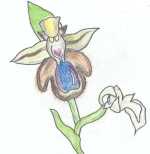|
|
The pretty blue periwinkle (Vinca difformis) is one of the first flowers to bloom in January. The most common variety is blue but violet-pink flowers are also found. They will flower well into spring. The mirror orchid with its bright and shining blue lip is a common Algarve ground orchid. The Algarve is home to a variety of these orchids which bloom in March. See this page for a description and illustration of the Algarve orchids. Among the cistus scrub on hillsides, small bushes with tiny brilliant blue flowers are very distinctive. They are the scrambling gromwell Lithodora diffusa. A plant which produces brilliant blue hemispherical inflorescences which make a bright splash in fields and along roads is the Peruvian Squill (Scilla peruviana.) My illustration shows the flowers which make up part of the hemisphere. White irises bloom as early as January and the smallest European iris makes an appearance in March. The Barbary nut (Gynandriris sisyrinchium) has bright blue, white and yellow blooms which open only after 3 o'clock in the afternoon closing again after dark. Another flower along the roadside which starts to produce a stunning display is the "bugloss" Echium tuberculatum. Its flowers are a brilliant purple carmine turning blue as they age. A little less glamorous is a plant with inconspicuous pale dusky-pink flowers. These also change as they age becoming pale blue-grey with delicate navy-blue veins. This is the Blue Hound's Tongue, (Cynoglossum creticum.) Some strange plants in the Lily family are found in grazed fields. The tassel hyacinths (Muscari comosum) have an inflorescence of tiny green-brown flowers with a iridescent blue "tassle" of sterile flowers on top. Bellevallia hackelii has similar flowers but no tassle. Its young flowers are pale-blue and the older ones dark violet. Finally, the common Grape Hyacinth Muscari neglectum is a very variable species with narrow linear leaves. The area is home to many thistles. One of the first to bloom is Centaura pullata with its pink-lilac flowers and pale grey-green leaves.
Fragrant Rosemary bushes begin flowering in January. This is a widespread bush in the Mediterranean region, from Portugal and as far east as Lebanon. Blue flowered varieties are the most common but but white and pink varieties are also found. It is widely cultivated. In cooler shady places you may come upon the Spanish bluebell (Scilla hispanica). It differs from the English bluebell having blue anthers and wider spreading petals. Small hairy borage plants (Borago officinalis) look like misty clumps until you get close and see the brilliant blue flowers whose heads hang down.
|
Spanish Bluebell
|
WINTER, WHITE AND GREEN FLOWERS
WINTER, PURPLE, LILAC AND VIOLET FLOWERS
© (Text and Artwork) Irene Shepard 2002 .












